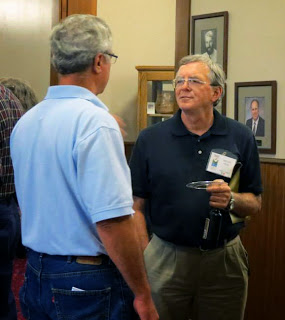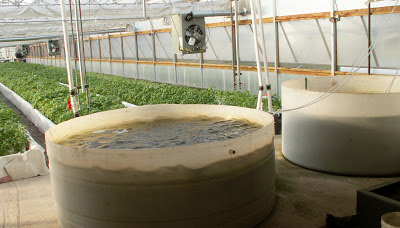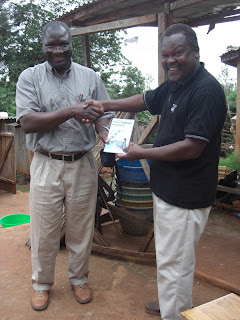July 2nd, 2014 by iisg_superadmin
Protecting fish populations worldwide while still meeting the steadily increasing demand for fresh seafood is a critical challenge facing several countries, but aquaculture (fish farming) is making significant advances in efficiency and sustainability that can meet those needs.
“Globally, we’ve hungered for 3.2 percent more seafood every year for the last five decades, double the rate of our population. Yet more than four fifths of the world’s wild fisheries are overexploited or fully exploited (yielding the most fish possible with no expected room for growth). Only 3 percent of stocks are considered ‘underexploited’—meaning they have any significant room for expansion. If we continue to fish at the current pace, some scientists predict we’ll be facing oceans devoid of edible marine creatures by 2050.
Aquaculture could come to the rescue. The Food and Agriculture Organization of the UN predicts that farmed fish will soon surpass wild-caught; by 2030, aquaculture may produce more than 60 percent of fish we consume as food.
One of the most pressing concerns about aquaculture, though, is that many farmed fish are raised on a diet of 15 million tons a year of smaller bait fish—species like anchovies and menhaden. These bait—also known as forage fish—are ground up and converted into a substance called fishmeal. It takes roughly five pounds of them to produce one pound of farmed salmon. Bait fish are also used for non-food products like pet food, makeup, farm animal feed, and fish oil supplements.
It may appear as though the ocean enjoys endless schools of these tiny fish, but they too have been mismanaged, and their populations are prone to collapse. They’re a ‘finite resource that’s been fully utilized,’ says Mike Rust of NOAA’s Fisheries arm. Which is disturbing, considering that researchers like those at Oceana argue that forage fish may play an outsize role in maintaining the ocean’s ecological balance, including by contributing to the abundance of bigger predatory fish.
And that’s where Belov’s trout come in: Though he swears no one can taste the difference, his fish are vegetarians. That means those five pounds of forage fish can rest easy at sea. It also means that the trout don’t consume some of the other rendered animal proteins in normal fishmeal pellets: like bone meal, feather meal, blood meal, and chicken bi-products.”
Read the complete article at the link above for more about recent developments in aquaculture, and visit our aquaculture page for further information.
September 25th, 2013 by Irene Miles
The Purdue University Department of Forestry and Natural Resources (FNR) celebrated their centennial anniversary from September 20-22, and included back-to-class sessions, tours of FNR buildings including the aquaculture research laboratory, and a Saturday evening banquet. More than 250 guests, including many FNR alumni, joined in the celebrations.
 FNR has spent the past 100 years training professional foresters, fishery and wildlife scientists, and natural resource managers who help to preserve and protect environmental resources throughout the country.
FNR has spent the past 100 years training professional foresters, fishery and wildlife scientists, and natural resource managers who help to preserve and protect environmental resources throughout the country.
Illinois-Indiana Sea Grant (IISG) has proudly partnered with FNR for more than 30 years. Brian Miller, IISG Program Director, said, “The Illinois-Indiana Sea Grant College Program highly values our 30 year partnership between NOAA, Purdue University, and the University of Illinois. This type of bi-state partnership only works in one other Sea Grant college in the country, and only works because of the mission-driven spirit of collaboration that exists on both of our campuses. The innovation, dedication and creativity of FNR have helped make the Illinois-Indiana Sea grant college program successful and enabled us to achieve positive impacts for local communities and the Great Lakes ecosystem.”

Recent IISG work was showcased during a welcome reception Friday night, and IISG staff assisted in organizing several of the celebration events throughout the weekend. Numerous current IISG staff members have worked closely with FNR, including Miller, Angela Archer, Carolyn Foley, Tomas Hӧӧk, Kwamena Quagrainie, and Kara Salazar, and the partnership continues to offer a crucial link in protecting coastal areas and waterways.
*Photos courtesy the FNR Centennial Committee
September 12th, 2013 by Irene Miles
IISG staff will have the opportunity to see aquaculture in action next week while touring the Bell Aquaculture facility in Albany, IN. IISG’s Kwamena Quagrainie has been studying and providing expert advice to aquaculture operations in the Midwest and worldwide for many years, and will be giving the staff more information on how the facility provides millions of pounds of sustainably grown fish to the market each year.
Aquaculture has been a growing food field in the state of Indiana, and a recent feasibility study funded in part by IISG (available online soon at our research projects page) shows that it may have significant potential in Illinois as well.
Additionally, Purdue University produced this great video about aquaponics, which is an extension of aquaculture where fish and plants are raised sustainably and simultaneously in a mutually beneficial system.
Learn more about aquaculture on our aquaculture page.
August 19th, 2013 by Irene Miles
Aquaculture, the business of raising fish for commercial sale, is a growing part of Indiana’s agriculture practice, and Illinois-Indiana Sea Grant’s Kwamena Quagrainie is just one of the people helping to make that possible.
From Purdue University:
“Estimated sales from Indiana fish farms amounted to more than $15 million in 2012, an increase from $3.5 million in 2006, according to the publication Economic Importance of the Aquaculture Industry in Indiana. There are about 50 fish producers in Indiana, compared with 18 just seven years ago.
‘While aquaculture is not the most well-known industry in Indiana’s agriculture sector, it is definitely present and very important to the state’s economy,’ Kwamena K. Quagrainie, aquaculture marketing specialist in Purdue University’s Department of Agricultural Economics, said in the report. He conducted the study with graduate student Megan C. Broughton.
‘The industry has seen steady growth over the past few years, and it is important to know exactly how much economic activity is associated with aquaculture in Indiana,’ Quagrainie said.
Indiana’s aquaculture industry ranges from small-scale producers raising fish in their backyards to large-scale producers growing fish to sell in national and international markets, the report says. The industry includes production of fish for human food, ornamental fish for aquariums and recreational fish that are stocked in private and public ponds and lakes.”
March 11th, 2013 by Irene Miles
Illinois-Indiana Sea Grant, along with several other Sea Grant programs, universities, and researchers, have been involved in advising and establishing a number of aquaculture operations in the U.S. and around the world, including some aquaponics facilities. This video from our friends at Purdue University provides a terrific amount of detail about aquaponics and how the process could help sustainably grow food.
With the ability to grow plants and fish in a mutually beneficial system, aquaponics presents an especially viable and sustainable option to provide healthy and locally grown food for urban areas.
From The Atlantic Cities:
“Aquaponics is a method of combined fish and vegetable farming that requires no soil. The farmer cultivates freshwater fish (aquaculture) and plants (hydroponics) in a recirculating water system that exchanges nutrients between the two. Wastewater from the fish serves as organic fertilizer for the plants, while the plants clean the water of fish feces and urine. The net result: a 90 percent reduction in freshwater use compared with conventional fish farming, and a significant reduction in added nutrients such as fossil fertilizers. The system can be run without pesticides and, because the fish environment is spacious and clean, without antibiotics…
In the lab, the pumps made gushy sounds at regular intervals. The water dripped. As the plants’ leaves evaporated moisture, I could hear the place breathe. I picked a ripe, red tomato from a vine. This lab, I sensed, could morph into an urban oasis: a lush, breathing organism inside the city. Unlike static green spaces like parks, this would be an actual farm as well as a place of tranquility in the city — not to mention a space that could generate the food to feed that city, with minimal harm to the environment or human health, just steps from residents’ tables.”
Follow the link above to the complete article, and visit our aquaculture webpage for more information.
February 7th, 2013 by Irene Miles
IISG’s Aquaculture Marketing Specialist Kwamena Quagrainie, who also directs the aquaculture economics and marketing program at Purdue University, was recently promoted to the position of Clinical Engagement Assistant Professor in Agricultural Economics. Dr. Quagrainie has been involved for many years in aquaculture marketing and outreach, helping numerous aquaculture operations get started or expand their business throughout the Midwest. He has also been involved in international efforts to promote and foster aquaculture operations throughout several African nations.
The Clinical Engagement professorship emphasizes transfer of applied research results to aquaculture communities small and large. The goal of this position is to promote active engagement in a field, which is the type of work that Dr. Quagrainie has been directly involved in for many years now. This promotion will give him even more opportunities to bring his expertise to aquaculture producers–helping businesses and communities grow.
December 3rd, 2012 by Irene Miles
Illinois-Indiana Sea Grant aquaculture marketing specialist Kwamena Quagrainie was recently recognized for his many years of work in developing and improving the business practices, marketing, and success of aquaculture operations both in the state of Indiana and internationally through his efforts in several African nations.
The Purdue University Cooperative Extension Specialist Association’s (PUCESA) mid-career Award “recognizes an Extension specialist with 11-20 years of service. Recipients would have demonstrated extension leadership; excellence in delivering public education programs; innovative approaches to program development; outreach efforts to county Extension educators; research that benefits Extension clientele through practical application; or demonstrated collaboration with county educators, agencies, or community leaders.”
The text of the nomination provides more detail on Dr. Quagrainie’s work:
“Since joining Purdue in 2005, Dr. Kwamena Quagrainie has revitalized the aquaculture industry in Indiana and overseas. Through applied research and Extension he has expanded aquaculture funding and improved business for thousands of fish farms.
Kwamena’s leadership led to reorganization of the state aquaculture Extension team and development of a business management program for farms producing yellow perch, hybrid striped bass and freshwater prawns. Kwamena’s leadership was a driving force in the Indiana Soybean Alliance funding a 5-year Indiana Aquaculture Strategic Plan in 2007 resulting in up to $1 million annually in soybean check-off funds for aquaculture research and education in Indiana. Kwamena obtained additional research funding from USDA and Purdue to support Indiana aquaculture development. He actively collaborates with Indiana Department of Natural Resources, Indiana Board of Animal Health, and the Indiana Soybean Alliance. Kwamena is Indiana’s state coordinator for USDA’s North Central Regional Aquaculture Center, state representative on the National Association of State Aquaculture Coordinators and serves on USDA’s aquatic task force that is formulating standards for organic aquaculture nationally.
 Dr. Quagrainie’s domestic program is closely integrated with international activities through the USAID-funded Aquaculture and Fisheries Collaborative Research Support Program (AquaFish CRSP). As the Africa AquaFish CRSP project director, Kwamena secured $1.13 million since 2004 for research and outreach, including training in pond record keeping and business management. About 2,000 fish farmers in Tanzania, Kenya and Ghana can now use their farming records to secure bank financing…”
Dr. Quagrainie’s domestic program is closely integrated with international activities through the USAID-funded Aquaculture and Fisheries Collaborative Research Support Program (AquaFish CRSP). As the Africa AquaFish CRSP project director, Kwamena secured $1.13 million since 2004 for research and outreach, including training in pond record keeping and business management. About 2,000 fish farmers in Tanzania, Kenya and Ghana can now use their farming records to secure bank financing…”
For more information about Illinois-Indiana Sea Grant’s aquaculture resources, visit our Aquaculture Economics & Marketing Resources page.








